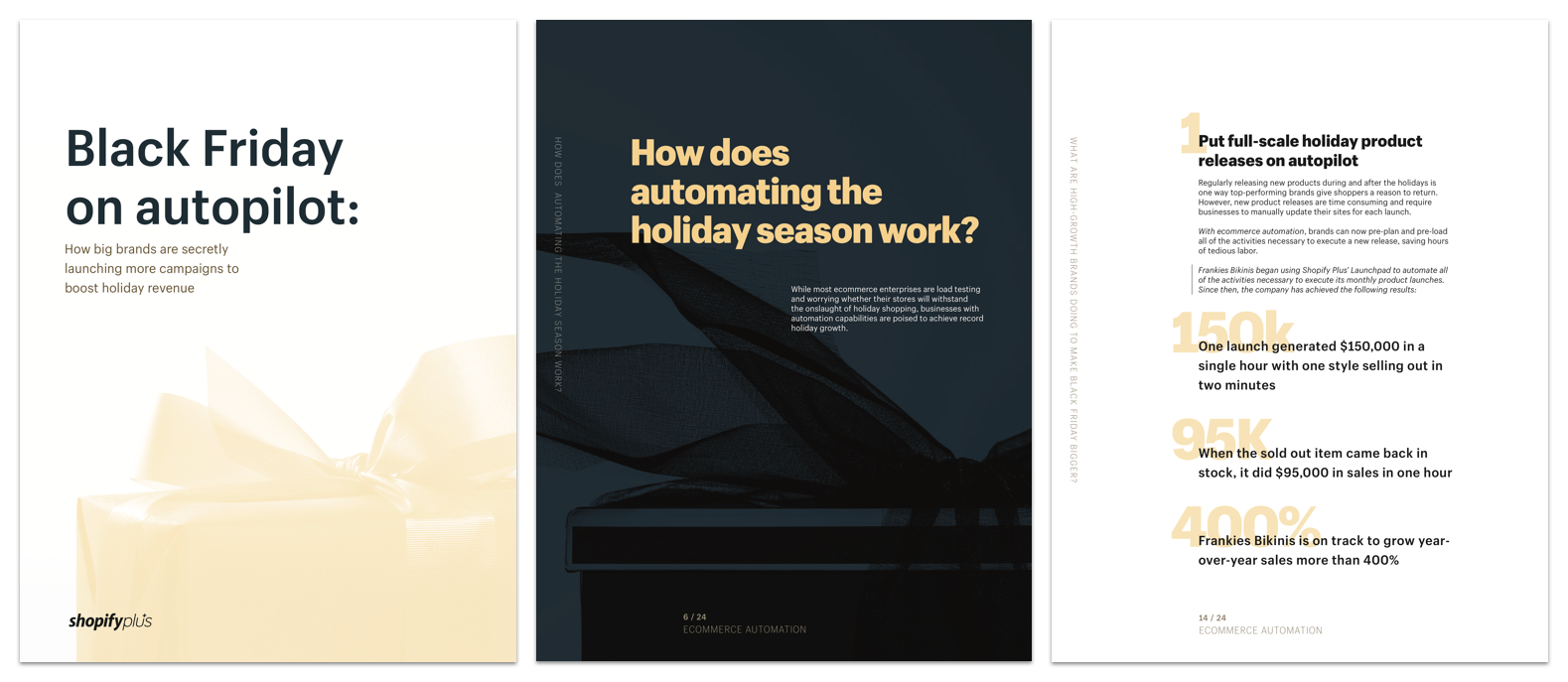- Shaving one month off a migration project, Rehash saved 750 staff hours by automating the tagging and merchandising of 300K products
- High-growth agency DBNY helped Trublooms to automatically store customer information for future market expansion opportunities
- Fuel Made brought together the trifecta of ecommerce automation to help Velour Lashes run 12 campaigns in 12 consecutive days last holiday season, all on autopilot
Ever wish you could clone you and your agency staff to get more work done faster and more affordably?
Staffing up versus more substantial profits is a precarious balancing act. If the client doesn’t stick around long-term, will you have enough work for that new employee afterward? Should you hire freelancers to help fill in the gaps?
Now, there’s a new option for Shopify Plus Partners — and merchants — to get to meet tight deadlines without exhausting teams or adding costs.
Ecommerce automation- which Plus brands have used to sell more than $3 billion on autopilot- can help you streamline tasks and ideas, and automate seasonal sales and promotions that can be integrated with custom code to make your client’s customer experience unique to their website.
Three Shopify Plus Partner Agencies are revealing how to …
- Uncover the Need for Ecommerce Automation
- Create Operational Solutions: Three Use Cases
- Integrate the Shopify Plus Automation “Trifecta” 🎁
- Sell Ecommerce Automation to Large Clients
- Expand Your Agency Without Adding Costs
The secret to launching more campaigns, faster
Keep reading to find out how Shopify Plus Partners are saving time and helping their clients sell more. But if you’d like to go behind-the-scenes on automation this holiday season, then download our exclusive new guide: Black Friday on autopilot.
1. Uncover the Need for Ecommerce Automation
With a decade-long love of ecommerce design and development, plus years of experience helping to launch retail stores for big brands like Apple, the team at Rehash knows a lot about streamlining business operations.
That’s why they always begin with an exploration phase when kicking off a new client project. The goal? To uncover inefficiencies that can be solved with automation tools or re-allocating staff responsibilities.
“Whenever we’re considering a project together, or maybe we’ve already taken them on as a client, we’ll have them write out customer journeys,” explains Johnson. “That could be their wholesale customer journey or a consumer customer journey. It could even be staff journeys.”
The Rehash team uncovers important details during this exercise by asking their clients and themselves questions like:
- What’s the experience like interacting with your brand throughout different touch points?
- If I was in a user’s shoes, what would be the pain points for me in this situation?
By going through that discovery phase, red flags like repetitive processes will bubble up to the surface...

“You know if you hear the words copy and paste or spreadsheet, there’s usually room for improvements, maybe even for some automation,” says Johnson. “While pinpointing areas that can be automated, we also look for situations where it’s necessary to take out a middle-man; wherever a ball might get dropped.”
Similarly, with a focus on providing holistic solutions and creative problem-solving, the team at DBNY identifies the need for automation while building out a client’s overall strategy after winning a new project.
One of the hardest parts of running a business is scaling your staff, and knowing who to hire and where it’s good to invest.
Das says one of DBNY’s greatest value-adds to merchants is thinking about how each piece of the solution works together; they can be independent, but they don’t have to be completely siloed.

“When you’re first thinking about automation solutions, you must consider all of the tools in your arsenal – whether we can do X with Shopify Flow, or Y with Scripts and Z with Launchpad,” says Das. “Then, boom! Now we have a framework for how we’re going to create this automation solution with all or some of those three products.”
As we’ll explore more, Das believes it’s important to lean on combining those automation tools to accelerate what types of solutions you’re going to be building.
“If they aren’t connected right now, it’s great to know that there are options of doing so in the future. And then you can get a little more creative with the solutions you develop,” he says.
2. Create Operational Solutions: Three Use Cases
When merchants have thousands of products in their inventory or are collecting data on customers to use later for a targeted promotion, you can eat up hundreds of staff hours manually tagging and tracking that information.
Both DBNY and Rehash have recently worked with clients to develop creative ecommerce automation solutions that save time and money to invest elsewhere in their businesses.
Gazelle Sports: Streamlining the Product Tagging Process
Within their 300,000+ product catalog, Gazelle Sports and Gazelle Sports Soccer sells thousands of unique football club (FC) soccer tees. But, just imagine typing in the term “FC” to find products for a professional club and, instead, your query returns dozens of high-school FC products.
On the front-end, that kind of experience is frustrating. On the back-end, it’s a nightmare.
To solve both problems, Gazelle Sports enlisted Rehash for what was possibly the most data-heavy Magento to Shopify Plus migration ever.
Before Shopify Flow existed, Johnson says his agency would start with a client’s master list of tags and have to manually make sure the casings all matched … or that somebody didn’t accidentally put a space or an ampersand in the wrong place.
Thanks to Shopify Flow, Rehash can now automate Gazelle Sports’ product data management and tagging.
“They needed certain tags added that sync up with products in their retail system. Trying to individually edit products at that high of a number just didn’t fit into reality. You can’t even really staff for it,” says Johnson.

If you can discover those issues up front and set up Shopify Flow to manage it as you’re migrating as well as when new products are added thereafter, Johnson says, it just makes everybody’s life easier.
Flow enabled Rehash to save approximately 750 hours of staff time for the merchant. That’s time that is usually spent configuring the product tags used to create auto collections, faceted filtering, and other soccer club-specific features throughout the website.
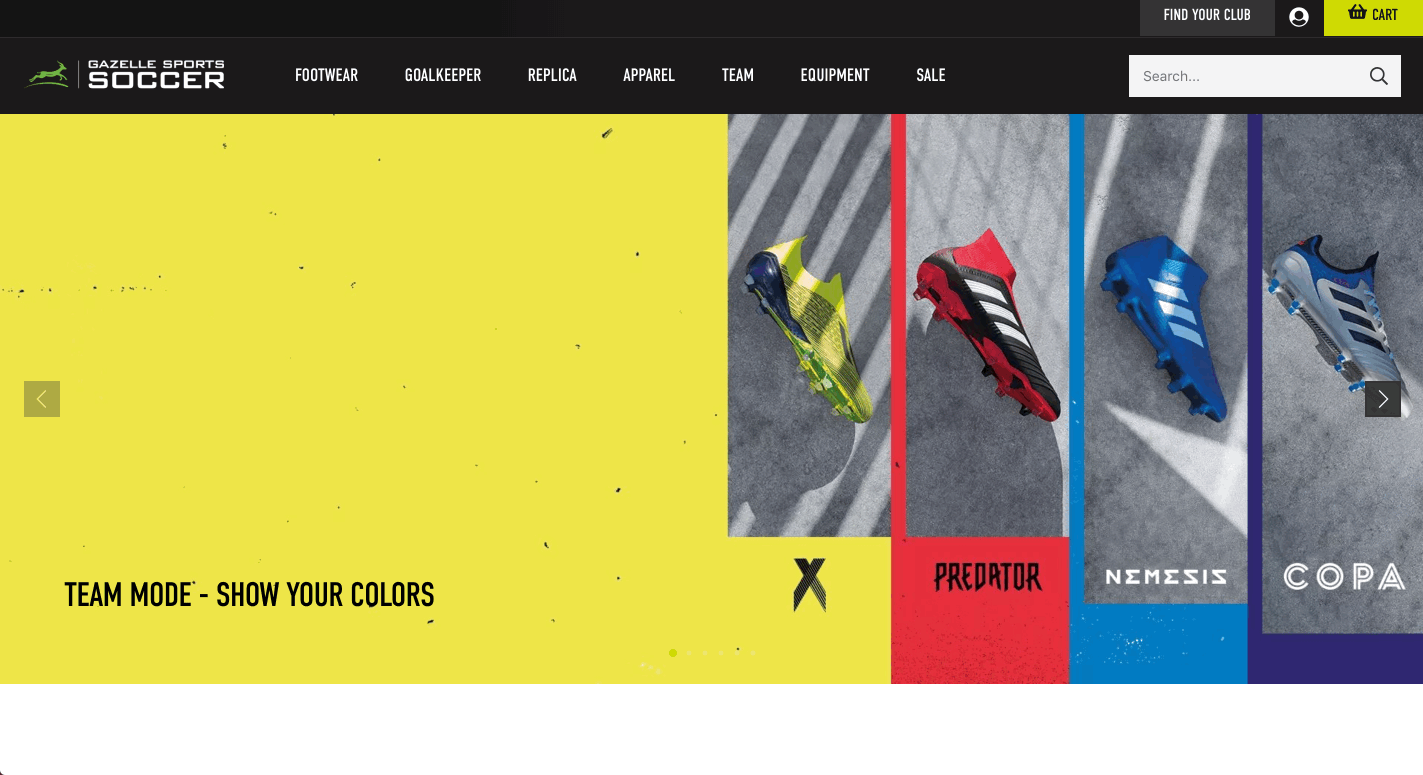
All told, Flow helped to shave off over a month’s worth of work from the migration portion of the project.
Trublooms: Zip Code Checker for Future Market Expansion
When your client’s business is hyper-local, it’s tough to turn away prospective customers who live in other zip codes.
That’s why DBNY built a special workflow for its flower subscriptions service client, Trublooms, that currently only sells up to a specific cross-street in Manhattan.
Trublooms has aspirations to one-day expand beyond their cut off at the borderline of Harlem to 125th street. So DBNY custom developed a workflow on Trublooms’ back-end that collects zip codes from prospective customers in other locations at checkout.
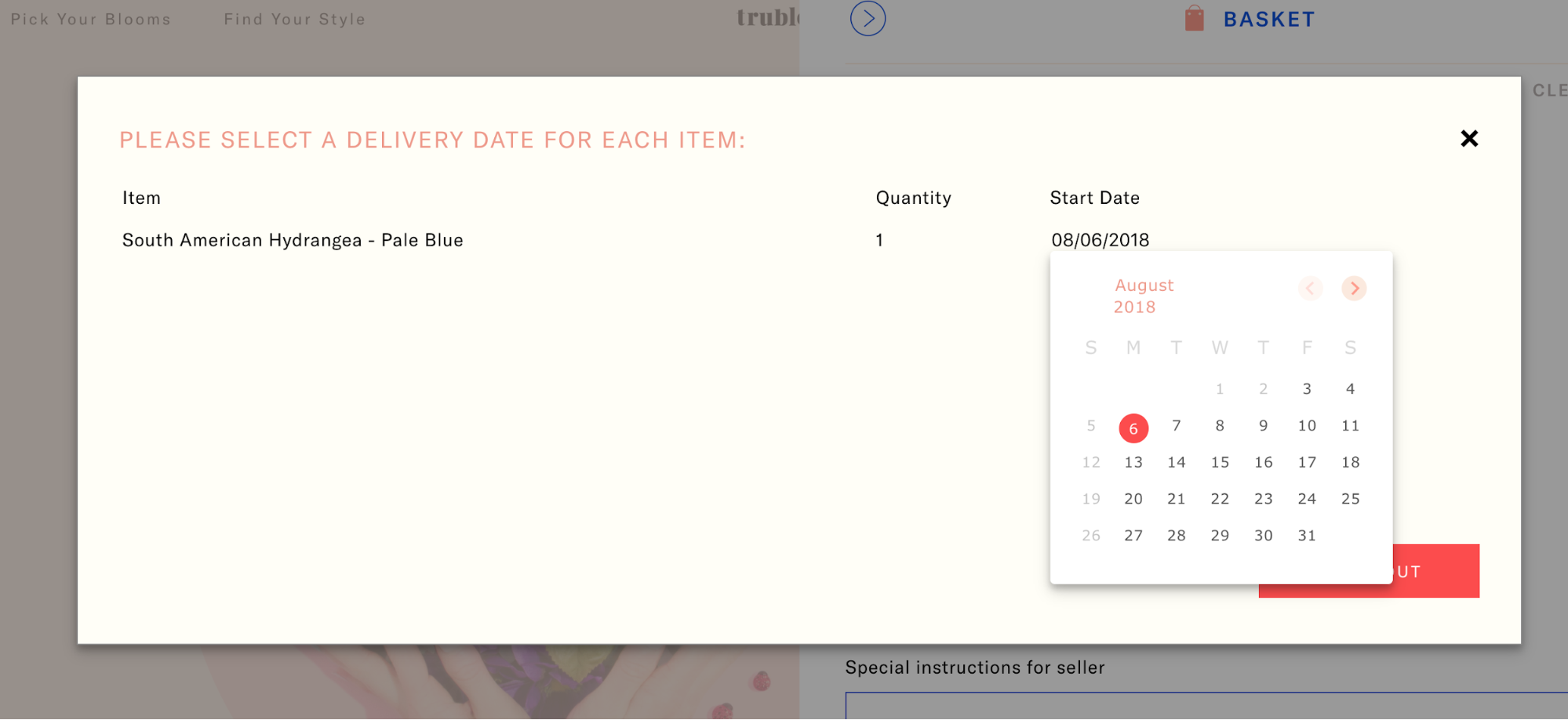
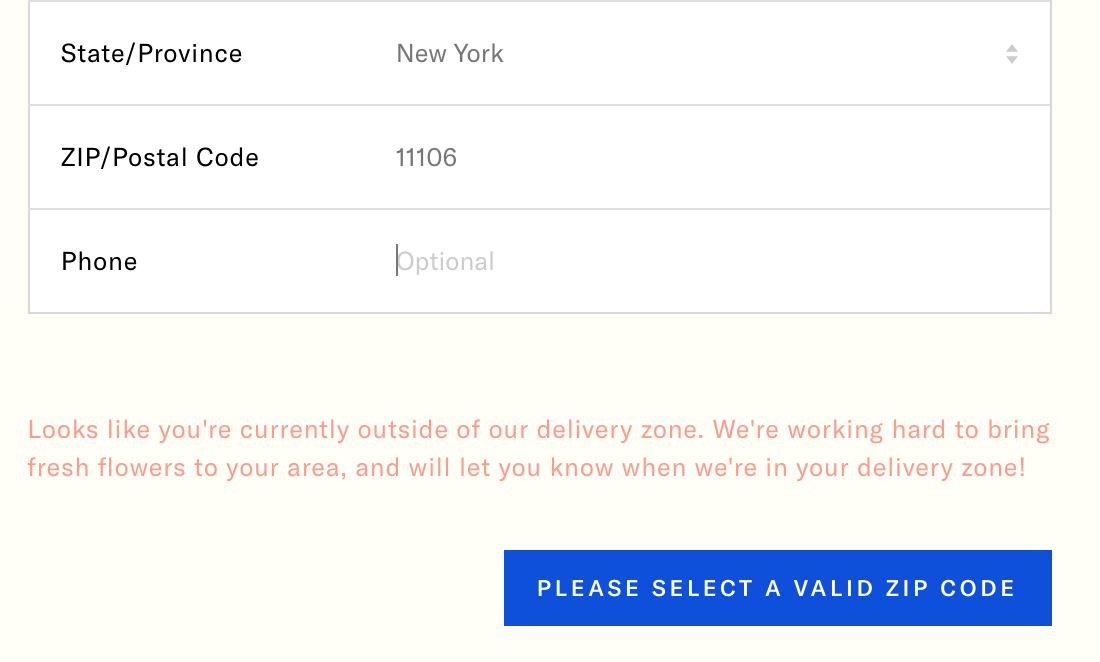
Once you select your delivery date, you must then input your zip code to see if you’re eligible for the delivery service. The zip code checker ensures that if customers are within Trubloom’s delivery zone, then they can finish the checkout experience.
We tested the concept with Flow and it was just so quick and so easy to build these workflows and actually make it work.
His team added some additional logic to see what prospective customers, who didn’t qualify for local deliveries, had added to their carts.
For marketing purposes, that information gets dumped into a spreadsheet and uploaded to their ESP for future use. “As they get more traffic and activity, this library of data is only going to arm the marketing team with more decision-making intel,” says Das.
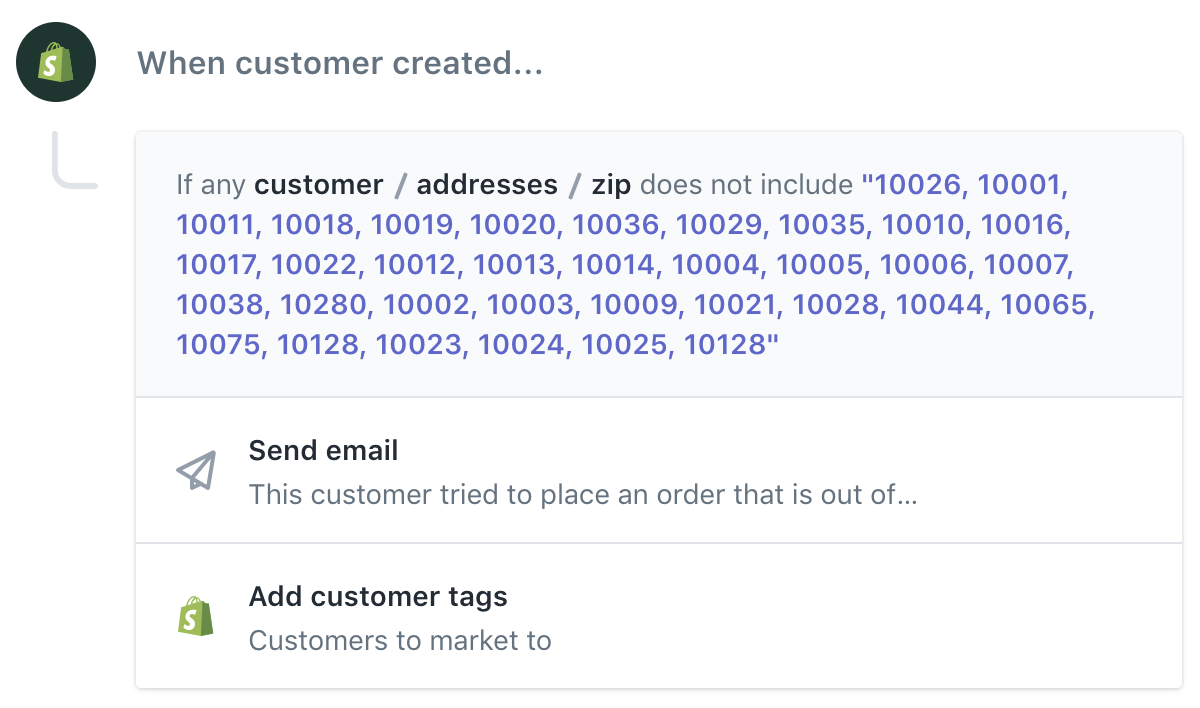
Before Flow, a developer at DBNY would have to figure out a workaround to segment those customers, or possibly build a private app.
Now, the agency can reallocate that precious developer time elsewhere, plus save the client a lot of money while Flow works quietly in the background.
Mixer Direct: Auto-Checking for State Tax Exemptions
Mixer Direct is one of the industry leaders on mixers and tanks for industrial locations. The company sells from five-gallon buckets and size mixers all the way up to 25 thousand gallon tanks that are used by whiskey distilleries.
For ecommerce sales made in Kentucky, the company has to apply a tax exemption for its customers, based on their use case for Mixer Direct products.
Before Shopify Flow, someone on the Mixer Direct team had to manually go through all of the orders to identify those that were coming from Kentucky. To solve for this problem, the team at Rehash:
- Added a questionnaire on the registration page to ask if the customer is tax exempt in the state of Kentucky
- Created a workflow on the back-end that identifies when a customer checks that box during registration
- Flow then tags those tax-exempt orders and sends an email to a Mixer Direct employee to review it before the order goes through

This workflow ensures that the customer gets their tax exempt status when they’re going through the checkout process.
It also saves Mixer Direct from needing a part-time employee to review every order that comes in, and it’s a quick win for the team as they can action the exemption immediately.
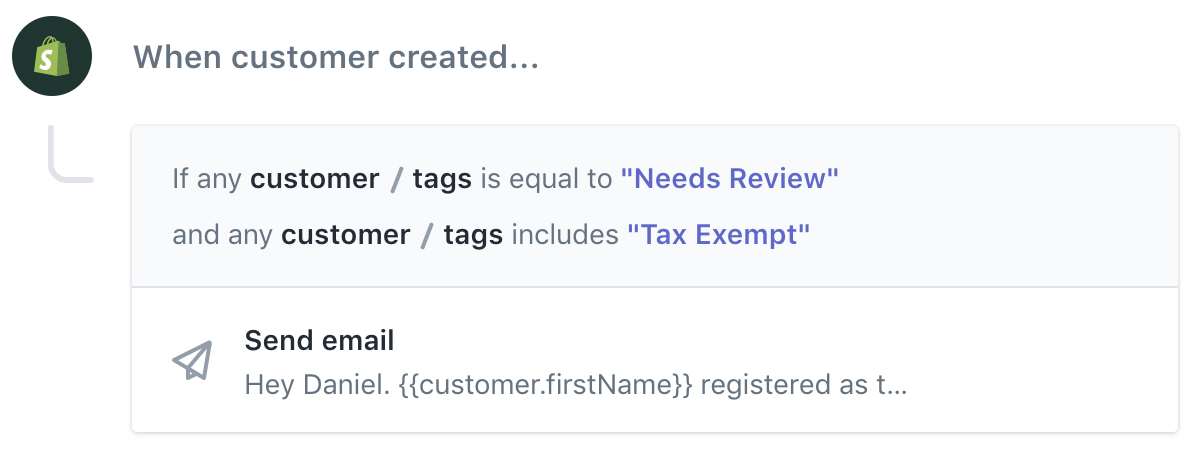
The information is also saved as a search on the Mixer Direct Shopify dashboard, so they can reference the list of tax-exempt customers as needed.
Johnson says this is a great example of offering a value-add to merchants by “understanding what they may see as normal, we see as a drain on a business. Shopify Flow is increasingly becoming a part of our problem-solving toolkit for our clients’ operational inefficiencies.”
3. Integrate the Shopify Plus Automation “Trifecta”
Shopify Flow is a powerful ecommerce automation tool on its own. But when you use it alongside other Shopify automation tools like Launchpad- Shopify merchants have used to sell more than $3 billion on autopilot- and Scripts, you get what Das calls “the Shopify Plus ecommerce automation trifecta.”
Last year, Shopify Plus partner Fuel Made developed a “12 Days of Christmas” campaign for its client Velour Lashes to drive sales during the holiday season.
In the past, a campaign of this magnitude would be a logistical nightmare. Someone on the agency or client team would have to:
- Spend 30 hours upfront developing and testing the 12-day campaign
- Exhaust an additional five hours building each sales event
- Stay up to activate and deactivate each at midnight
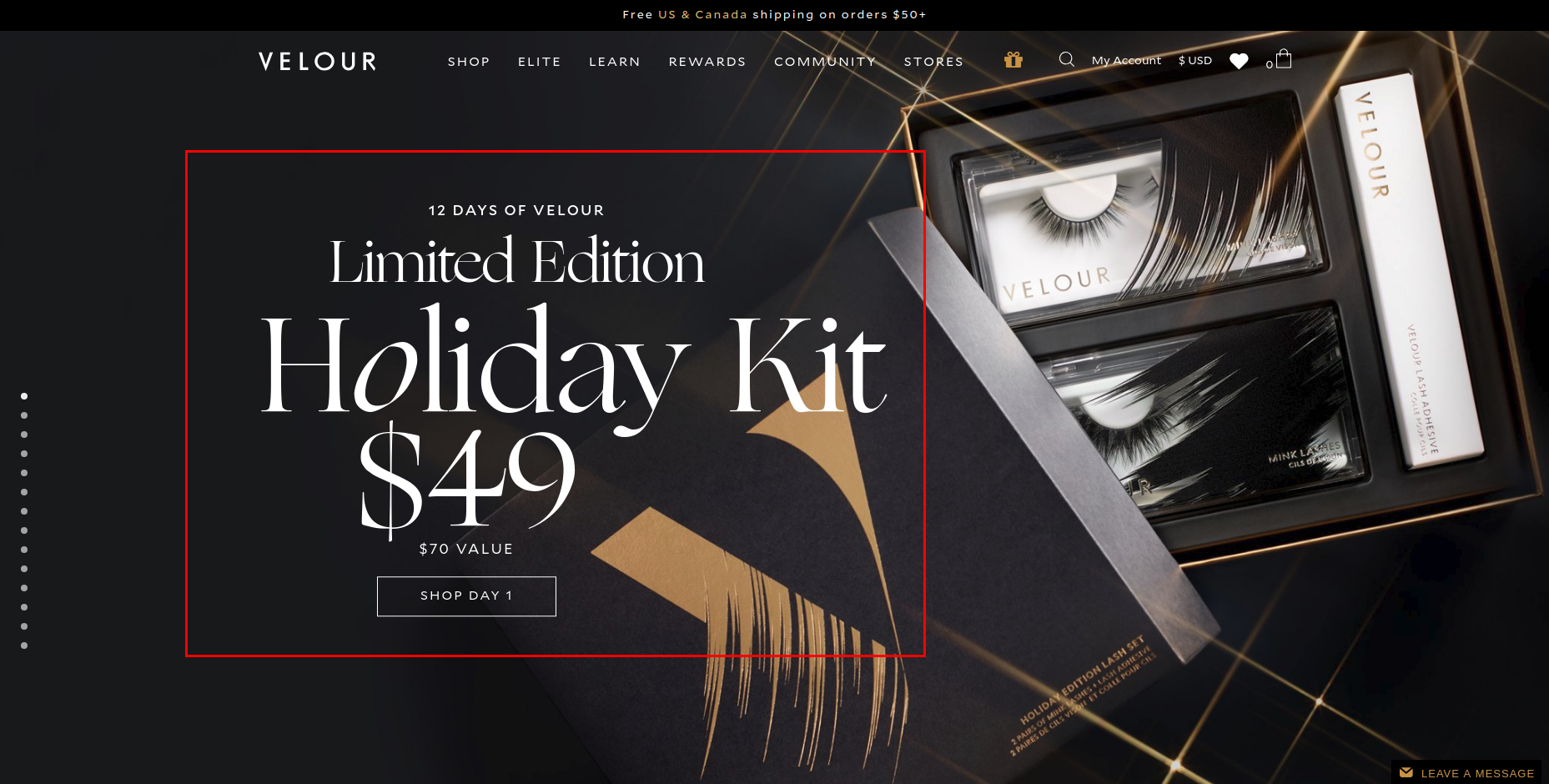
Using Launchpad, Fuel Made pre-scheduled each of the 12 sales events to automatically:
- Launch entire storefront theme changes
- Unpublish the previous day’s sales campaign
- Immediately update the site with a new theme for the next
- Publish scripts with the Shopify Script Editor app for each event
- Unleash special discount codes when required and roll them back

“Creating and pre-scheduling all of the themes ahead of time to be published via Launchpad saves us a lot of time, stress, and setup costs. The themes for each event can also be reviewed by the client before the day’s sale launches to ensure everything looks and functions as it should,” says Rick Murt, Web Developer at Fuel Made.
The agency did most of the theme set-up and pre-scheduling work, but Velour Lashes could go into Launchpad to preview and modify the promotional text for sales events themselves:
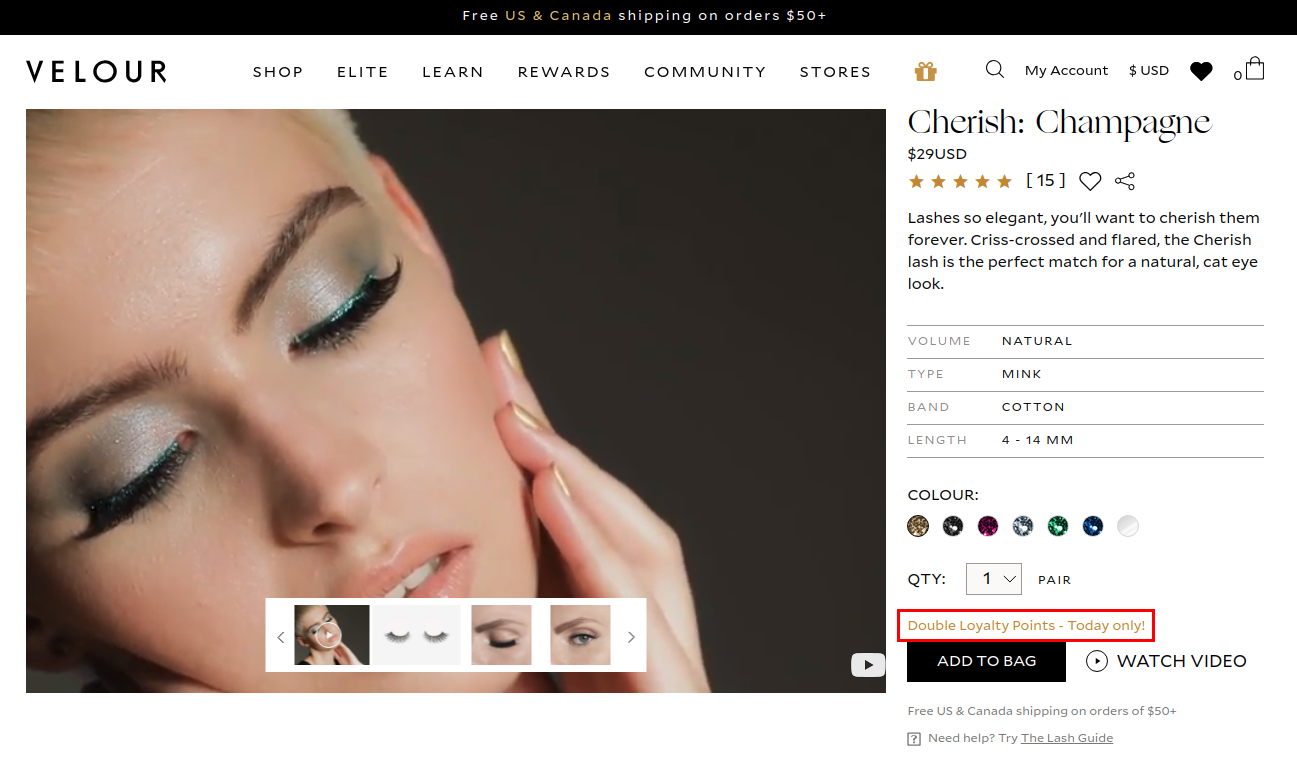
Since Launchpad is so easy to use, the Velour Lashes team will be re-purposing the best of last year’s themes and pre-scheduling sales events on their own for the 2018 holiday season.

“We use Launchpad for pretty much all of our product launches and promotions. Since our website traffic is at its peak outside of typical office hours, Launchpad is an essential part of our marketing strategy,” says Caitlin Copetti, Marketing Manager at Velour Lashes.
Integrating Shopify Scripts with Launchpad Themes
Shopify Scripts were integrated with the Launchpad 12 Days of Christmas themes to customize some of the sales events. BOGOs were a common promotion (which merchants can now natively set up with discounts via their admin), that was set up with Scripts.

Scripts were also utilized to verify the minimum orders in a customers’ cart to ensure that they qualified for a free gift with purchase. For example, on Day 10 Velour Lashes offered a Free Tripack with a $75 purchase using the discount code “TRIPACK75.”
The Velour team can measure their success using custom Scripts and Launchpad. Via a Launchpad dashboard, they can see the sales being generated in real-time when the theme is live, and create custom limitations or exclusions during the sale.
Future Plans to Integrate Shopify Flow
Velour Lashes and its agency didn’t make use of Shopify Flow last year but plan to do so in 2018 with the addition of connectors for Shopify Flow. One of the 2017 12 days’ sales events involved an offer to double loyalty points through Loyalty Lion.
Unfortunately, the points had to be manually added via the admin when an order was created.
Now that Loyalty Lion has Flow triggers and actions, Velour Lashes could potentially use the workflow below which triggers the points to be added automatically if a discount code like “DOUBLEPOINTS” is used:

This new workflow could enable the Velour Lashes team to re-allocate their valuable time spent on manually adding loyalty points elsewhere to focus on maximizing campaign results.
4. Selling Ecommerce Automation to Large Clients
Once you’ve experienced how effective ecommerce automation can be to help your team do more with fewer resources and find cost savings for your clients, it’s time to think about how to sell it through to prospective clients.
Das from DBNY likes to let the cost and resource efficiency of the Shopify Plus platform, powered by the “trifecta of ecommerce automation” (Flow, Launchpad and Scripts), speak for itself.
Das says he rarely sells on features alone: “We simply highlight how good Shopify Plus is; how we’re able to execute quickly. You don’t need to pay for another app, or for another service.
It’s all within Plus because we can modify and give you something that you didn't have before. And you’re not paying anything extra for that.
To stand out from other agencies, Das and his team focus on continuously pushing the boundaries of what is possible on Shopify Plus.
On the flipside, Johnson from Rehash recommends selling automation solutions upfront, before undergoing a major project like a platform migration:
“As we’re walking through those customer journeys and some repetitive processes come up,” Johnson notes, “we’ll identify specifically where Shopify Flow could step in and solve some of the challenges without us having to hire more app developers.”
Knowing that it’s an added financial stress for both the agency and the client, Rehash includes the potential cost savings to their pitch. “We’ll put all that into our project summary – explaining that we’re going to automate using Shopify Flow to do that,” says Johnson.
He argues that seeing how automation fits into the overall strategy up front demonstrates to the client that your agency is thinking of ways to improve their business and is looking for ways to save them time and money.
“That helps make the sale of an agency whenever you’re selling Shopify Plus,” says Johnson.
It helps distinguish you as somebody who’s not just a good designer and developer, but somebody who’s really gonna help them grow and streamline their business.
He warns that some merchants don’t yet understand the power of automation tools like Shopify Flow. So, you must explain it to them early on to avoid them skipping over the opportunity and not using it because it sounds like too much work to get setup.
5. Expanding Your Agency Without Adding Costs
Ecommerce automation is helping Shopify Plus Partner Agencies to do more for their clients while re-prioritizing their staff’s billable hours to focus on more growth-oriented work.
“Relying on Shopify Flow,” says Johnson, “has saved our team the overhead of hiring another junior developer to oversee smaller programming tasks and applications that are now well within the capabilities of Flow.”
All three agencies can now hire more progressively in the areas of importance to their business and future goals.
Maximizing the use of Flow, along with Launchpad and Scripts also shows that the Plus Partners always have their clients’ best interests in mind.
From Das’ perspective, “It’s a huge value-add to merchants if you can connect the dots and demonstrate how all of these automation tools work together to grow their business while saving them money.”



